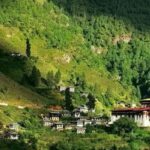Stunning Fuzhou Travel Attractions To Enjoy

Fuzhou, known as the City of Lakes and Mountains, boasts numerous interesting sights and experiences for visitors. Forest parks, beautiful gardens, historic temples and an exquisite tea culture all converge here for an unforgettable visit.
Fuzhou is best visited from September to November when its temperatures cool off significantly and become much more comfortable overall. During these months, summer heat vanishes while weather remains enjoyable all-year-round. For easy access, we recommend options like Cathay Pacific’s Johannesburg to Fuzhou flights.
1. West Lake Park
Fuzhou’s West Lake Park () is an essential visit. Boasting a tranquil lake, over 600-year-old Zhenhai Tower and an observation platform with magnificent views over its lake, cityscape and nearby mountains – not forgetting traditional Chinese restaurants and shops!
West Lake Park is most often visited during autumn and winter months from October to December when temperatures are generally cool and dry; making this the ideal time to experience its many natural and cultural sights.
From the lakeshore, taking a boat tour around West Lake is simple. Or explore Sanfang Qixiang alleys dotted with ancient cobblestone paths and traditional Ming and Qing architecture; experience local culture through attending one of Fuzhou’s Minju performances!
Fuzhou offers many top activities, but one of the main ones for history enthusiasts should be visiting the Fujian Province Museum where over 200,000 cultural artifacts can be admired. Situated between West Lake and Zuohai Lake, it makes an excellent cultural heritage attraction.
City is also famous for its tea culture and you can find several tea purveyors throughout. Additionally, you must visit the stunning 3-Laned and 7-Alleys historical block for beautiful laneways featuring lanterns. Additionally, SilkAir, a regional wing of Singapore Airlines provides full service flights with meal services and reclining seats; additionally its airport provides quick connections to most major Chinese cities so booking flights online or at ticket counters should not be an issue – located approximately 50 kilometers (31 miles) from city center
2. Fujian Province Museum
As one of Fujian’s national first class museums since 1953, this expansive complex should not be missed by culture lovers. The impressive concrete building contains sections that resemble traditional tulou dwellings (earthen dwellings of the indigenous Ke people) as well as architectural elements reflective of Fujian’s rich cultural heritage. The main halls are organized around three basic themes – ancient historical relics, revolutionary history and natural resources – with highlights including an antique coffin boat dating back three millennia and hundreds of costume pieces dating from over three millennia!
This year’s World Museum Day falls on May 18 and features “museums for sustainability and better lives”. To commemorate this event, The Museum will host various activities related to its theme such as exhibitions, dialogues, seminars and other special events that celebrate this date.
Fuzhou provides visitors looking to discover ancient dwellings with plenty of well-preserved examples, ranging from Sanfang Qixing in central Fuzhou to Honglicuo and Songkou in its suburb areas – many occupied by local residents that offer insight into Fuzhou’s social fabric; in addition, sacred temples such as Yongquan Temple and Hualin Temple should not be missed!
Autumn from September to November is an ideal time for hiking and exploring temples and old town, as the summer heat gradually subsides and temperatures remain at around 18deg. Additionally, this period also sees the annual Xiamen International Film Festival take place.
3. Pingtan Island
Pingtan Island lies at the border between Fujian and Taiwan and has earned itself the name “China’s Maldives” due to its spectacular coastal scenery and variety of water activities. Under Fuzhou administration and nearby Putian City and Fuqing City, Pingtan boasts 126 islands that form its county.
This picturesque spot is famous for its sea abrasion landform, producing soft white beaches that make up its shores. This beach serves as a playground for many outdoor sports activities including kite flying competitions, cross-strait marathons, island bicycle racing competitions and sailing boat regattas – also an excellent setting for marine activities such as scuba diving and swimming.
Espiritu Santo is also home to many seaside resorts and an internationally-recognized seafood center, boasting abundant offerings of shellfish, shrimp and crab that visitors from other parts of the globe come specifically for. Fresh and flavorful cuisine awaits them here; providing visitors from other corners with something deliciously unique!
Pingtan Island is famous for its peaceful beaches with safe bathing conditions and convenient hotels that provide complete services systems – an excellent place for family vacations! A wide range of hotels is located here with perfect locations offering great value.
Yongquan Temple on Gushan Mountain (Drum Mountain) is one of Fuzhou’s most revered shrines and provides a perfect venue for leisure walking, physical training and lively chit-chat.
Sanfang Qixiang, a historic block located at the core of Fuzhou city, offers visitors an unforgettable experience of local life. Here, you will encounter unique architectural designs with over 270 ancient dwellings still standing well-kept – perfect for experiencing local culture as well as buying local snacks and souvenirs!
4. White Tower and Black Tower
Fuzhou’s White Tower (Bai Ta) and Black Tower (Wu Ta) are iconic landmarks that stand out in any crowd. The former was constructed by King Wang Shenzhi to repay their kindness while its counterpart is so named due to weathering over time – they’re both linked by a bridge, serving as symbolic representations of Fuzhou city and its suburbs.
Songkou Ancient Town can be found to the eastern side of Fuzhou Downtown and boasts over 60 well-preserved ancient dwellings dating back to Ming and Qing Dynasties. Additionally, this charming village hosts several noteworthy folk artificial exhibits that draw great interest.
Sanfang Qixiang, commonly referred to as Three Lanes and Seven Alleys, is a historical block that was established during the late Jin Dynasty (265 – 420 AD) and flourished during both Ming and Qing Dynasties. Considered an ancient street pattern alive today and serving as an “urban museum”, Sanfang Qixiang showcases traditional fishbone-shaped architectural style while guests can stroll peacefully through its village streets while discovering former residences of historical celebrities.
Visitors to Western Fuzhou can indulge in traditional delicacies like fish balls and oyster omelettes that have been enjoyed for centuries, as well as freshly-brewed green or milk tea, freshly-ground coffee or freshly-brewed green tea. For an authentic nightlife experience in Western Fuzhou head to Rongcheng Plaza (Rong Cheng Yan Chang). After dark it becomes an energetic hub where older generation local residents gather for square dancing, partner dancing or lively discussions.
5. Mount Wuyi
Mount Wuyi, situated south of Shanghai, is one of China’s most breathtaking scenic areas. Here, visitors can witness nature at work through breathtaking landscapes featuring rugged rocks, steep cliffs and clouds adorning every inch of space.
Xichan Temple stands as a revered center of Buddhism since the Tang Dynasty. Spend some time enjoying its beautiful litchi tree groves which inspired many Buddhist poets or tour its 36 halls adorned with artworks and ornate decorations – don’t miss the bronze thousand hand Bodhisattva sculpture which stands proudly before you!
If you want to witness another side of mountain life, visit Roaring Tiger Peak Scenic Area. Here, one can find One-line Sky Cave which gives the illusion that the sky has been split apart with an axe. Wannian and Sanqing palaces formerly served as sites for imperial sacrifices of mountain gods but now serve as memorial halls in memory of Song Dynasty philosopher Zhu Xi who founded Idealism Confucianism.
Visit Xiamei Village, an ancient town with narrow streets containing old buildings and stone houses that offers visitors an incredible glimpse into life in ancient Fuzhou.
Fuzhou is best visited between March and November when its vibrant blossoms of pink peach blossoms, red plum blossoms and white magnolia flowers emerge in full force. Additionally, this season offers milder temperatures for sightseeing and outdoor activities; furthermore Fuzhou boasts a subtropical monsoon maritime climate so temperatures don’t become extreme either hot or cold.















